Discussion B
第二分科会
Road and Traffic Safety
交通安全と道路
Profile of Moderator and Panelists
Abstract of Lecture and Powerpoint Slides
Lecturer: Mr. Fred Wegman
Yasunori Iida
Date and Place of Birth: 01/October/1941, Kobe, Japan
Nationality :Japan
Present Position: Professor of Kyoto University, Department. of Urban Management
Professional Qualifications:
・July/1972, Doctor of Engineering of Kyoto University
・March/1966, Master of Science of Kyoto University
・March /19, Bachelor of Kyoto University
Awards:
・May/1988 The award of JSTE (Japan Society of Traffic Engineers) for the distinguished paper
・May/1992 The award of JSTE (Japan Society of Civil Engineers) for the distinguished paper
Work Experience:
・May/1985 to date: Professor of Kyoto University
・March/1980 to April/1985 :Professor of Kanazawa University, Department of Civil Engineering, Japan
・July/1972 to February/1980: Associate Professor of Kanazawa University, Japan
・October/1970 to June/1972 Lecturer: of Kanazawa University, Japan
・June/1967 to September/1970: Research Associate of Kyoto University
Main Research Fields:
Traffic Engineering, in particular, Network Flow Analysis, Traffic Management
Systems, Traffic Demand Estimation and Transportation Network Reliability.
Current Professional Activities:
・Board Member of Directors of JSCE (Japan Society of Civil Engineers)
・Vice Chairman of JSTE (Japan Society of Traffic Engineers)
・Editorial Advisory Board Member for "Transportation Research, Part C"
・Chairman of the Research Committee for Enhancement of VICS
(Vehicle Information and Communication Systems) in Japan
・Executive Advisory Member of VICS in Japan
・Special Advisor for UTMS (Universal Transportation Management Systems) in Japan
Main Publications:
a. Books
1. M. G. H. Bell and Y. Iida: The Network Reliability of Transport, Pergamon, 2003.
2. M. G. H. Bell and Y. Iida Transportation Network Analysis, John Wiley & Sons,1997.
3. Y Iida et al.: Traffic Engineering, Kokumin-Kagakusha, 1992, (in Japanese).
飯田 恭敬
京都大学大学院工学研究科都市社会工学専攻
交通マネージメント工学講座(交通情報工学分野)教授 |
| 1941年 | 生まれ |
| 1964年 | 京都大学工学部卒業 |
| 1966年 | 京都大学大学院工学研究科修士課程修了 |
| 1970年 | 金沢大学工学部講師 |
| 1972年 | 金沢大学工学部助教授 |
| 1980年 | 金沢大学工学部教授 |
| 1985年 | 京都大学工学部教授 |
| 1996年 | 京都大学大学院工学研究科教授 |
専門は交通工学
著書は「交通工学」(国民科学社)等 |
Fred Wegman
Education:
1972 Technical University Delft
MSc. Civil engineering, traffic engineering
Employment record:
1972 - 1974 Service in Dutch army
1974 - 1977 Traffic engineer Municipality of Amsterdam
Responsible for projects in the following areas: design of infrastructure and road safety, safety of vulnerable road users, safety of public transport, data-collection and analysis.
1977 - Present SWOV Institute for Road Safety Research
- 1977 - 1989 researcher and research manager
- Responsible for projects in the following areas: road safety in built-up areas, traffic calming, speed and speed limits, seat-belt effectiveness, road side safety, accident black-spots, safety audits, (passive and active) vehicle safety, safety of cyclists and moped riders, incentive programmes for municipalities, elderly road users, legislation and enforcement, effects of bicycle facilities, accident analysis for municipalities, design of road safety plans etc.
- 1989-April 1999: Research Director
- Description of duties: Management of research projects, developing road safety strategies for the Netherlands, developing of evaluation schemes and policy information systems related to national, regional and local road safety programmes, developing of road safety research programmes (national and international).
- Since April 1999: Managing Director
フレッド・ヴェーグマン
学歴
1972年デルフト工科大学
理学修士(土木工学、交通エンジニアリング)
職歴
1972〜1974年 オランダ陸軍で兵役
1974〜1977年 アムステルダム市役所交通エンジニア
インフラストラクチャーの設計および交通安全、交通弱者の安全性、公共交通機関の安全性、データ収集および分析の各分野におけるプロジェクトを担当
1977年〜現在 道路安全研究所(SWOV)
- 1977〜1989年 研究員、研究マネージャー
- 下記の分野のプロジェクトを担当
密集地区の交通安全、交通騒音対策、速度および速度制限、シートベルトの効果、路肩の安全性、事故多発地点、安全性検証、車両安全性(衝突安全および予防安全)、自転車およびモーター付き自転車の安全性、自治体向け報奨制度、高齢道路利用者、法律制定および施行、自転車用設備の効果、自治体向け事故分析、道路安全計画の設計など
- 1989〜1999年4月 研究ディレクター
- 職務内容 研究プロジェクトの管理、オランダの道路安全戦略の開発、国家、地方、都市の道路安全計画関連の評価システムおよび政策情報システムの開発、道路安全研究計画(国内および国際)の開発
- 1999年4月〜 マネージンング・ディレクター
Hiroshi Matsui
Position:
Professor, Department of Civil Engineering. Faculty of Science and Technology, Meijo University, Professor Emeritus, Nagoya Institute of Technology
Degree: Doctor of Engineering from Kyoto University
Date of birth: April 10, 1941
Education:
Completed the Master course,
Graduate School of Engineering. Kyoto University in 1966
Positions held since graduation:
| 1966: | Research associate, Kyoto University |
| 1968: | Assistant Professor, Nagoya Institute of Technology |
| 1974: | Associate Professor, Nagoya Institute of Technology |
| 1983: | Professor, Nagoya Institute of Technology |
| 2002: | Professor, Meijo University |
| 2002: | Professor Emeritus, Nagoya Institute of Technology |
Specialties: Transportation Engineering, Urban Planning
松井 寛
名城大学理工学部建設システム工学科教授
名古屋工業大学名誉教授
| 1941年 | 生まれ |
| 1966年 | 京都大学大学院工学研究科土木工学専攻修士課程終了 |
| 1996年 | 京都大学工学部助手 |
| 1998年 | 名古屋工業大学講師 |
| 1974年 | 京都大学より工学博士の学位授与 |
| 1974年 | 名古屋工業大学助教授 |
| 1983年 | 名古屋工業大学教授 |
| 2002年 | 名城大学理工学部教授。名古屋工業大学名誉教授。 |
専門は交通工学、都市計画
著書は「交通ネットワークの均衡分析」(土木学会)等
Hisashi Kubota
Born in Yokohama, 1958.
B.Eng., Dept. of Civil Eng., Yokohama National University (1982)
M. Eng., Dept. of Urban Eng., University of Tokyo (1984)
Dr Eng., Dept of Urban Eng., University of Tokyo (1988)
Research Associate, Dept. of Civil and Environmental Eng., Saitama University (1988)
Associate Professor, Graduate School of Science and Engineering, Saitama University(1997)
Specialties; Traffic Calming, Urban Transportation Planning
久保田 尚
埼玉大学大学院助教授
| 1958年 | 生まれ |
| 1982年 | 横浜国立大学工学部土木工学科卒業 |
| 1984年 | 東京大学大学院工学系研究科都市工学修士課程修了 |
| 1988年 | 東京大学大学院工学系研究科都市工学博士課程修了。工学博士。埼玉大学工学部助手。 |
| 1989年 | 埼玉大学工学部専任講師 |
| 1992年 | 埼玉大学工学部助教授 |
| 1997年 | 埼玉大学大学院理工学研究科助教授 |
専門は地区交通計画、都市交通計画
著書は「都市交通計画」(技報堂)等
Fewer crashes and fewer casualties by safer roads Fred Wegman
Abstract
Human errors play a vital role in road crashes. This presentation deals with the prevention of human errors by proper road planning, design and renovation/maintenance: road safety considerations must play an explicit role in decision making in all three these areas.
In road planning, a road safety assessment should be made in order to take road safety transparently into consideration. Such a road safety assessment takes into account traffic volumes and traffic risks per road type in a road network. The road safey assessment is made parallel to other impact assessments.
In decisions on road design and renovation/maintenance cost-effectiveness calculations should be taken into account. Moreover, a targeted minimum safety level is agreed upon between road authorities in the Netherlands. We call this 'sustainable safety'. This concept focuses on three design principles: functionality, predictability, and homogeneity. These principles will be introduced briefly in this presentation.
If we implement this concept, we expect to build a consideribly safer road traffic system by reducing human errors and eliminating 'preventable crashes'. Of course public support needs to be created in order to get this challenging concept implemented and accepted by the population. Integration with other road safety policies is considered crucial.
|
Fewer crashes and fewer casualties by safer roads
Fred Wegman
SWOV Institute for Road Safety Research
The Netherlands
Where we are…
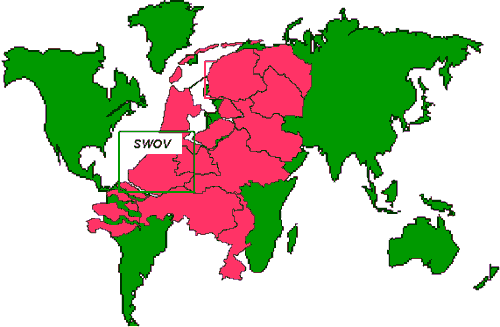
Four succesful countries in the past
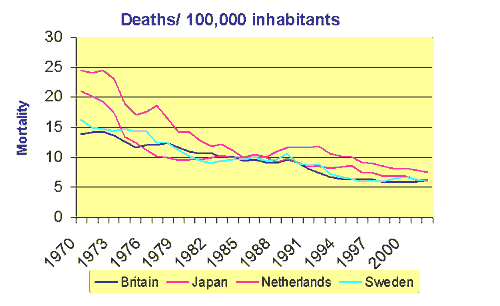
The History of Road Safety
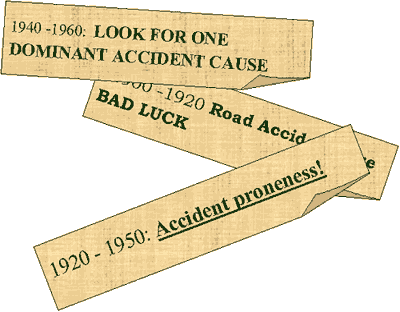
The History of Road Safety

…just one accident
- 18 years old
- Just passed his driving test
- Saturday night
- Drives his friends home
- …from a disco
- Windy dyke
- It’s raining
- Misjudges a bend
- Drives too fast
- Trees alongside the road
Cause?
- A young, inexperienced driver
- Driving at night
- In the rain
- With inappropriate speed
- An unexpected sharp bend
- Bold tyres
- Trees in a bend
- Don’t look for one single cause or one culprit!
New road safety paradigm
- Human errors are and will always be made
- Making human errors less likely by:
- Eliciting the desired/safe behaviour
- Making undesired error less likely
- Forgiving to human error by:
- Providing an opportunity to correct an error
- Reducing the consequences once a crash has become inevitable by system design based on ‘human tolerance’
Structure of the presentation
- Safety quality of roads
- Assessment of the safety quality
- Safety effects of improving roads
- Dutch vision: Sustainable safety
Safety quality of roads: indicators
- Frequency of crashes
- Exposure to risk: ‘crash rates’
How to explain differences in fatality risks per road type?
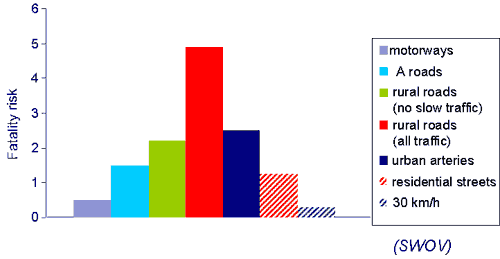
Safety quality of roads: indicators
- Frequency of crashes
- Exposure to risk: “crash rates”
- Safety performance function
Road safety engineering
- Safety conscious planning
- Safety conscious design
Aiming at:
- Minimizing exposure
- Minimizing crash risk
- Minimizing injury risk
Safety conscious planning
- Land use planning
- Route management
- Access management
Safety conscious planning: land use planning
- Minimize exposure:
- Efficient land use
- Efficient networks:
- Shortest routes coincide with safest routes
- Alternative modes
- Minimize crash risk:
- Minimize injury risk:
Safety conscious design
- The design characteristics are consistent with the road’s function (through or distributor or access) and elicit the appropriate behaviour
- Apply ‘design consistency’ along a particular stretch of road
- Use ‘available knowledge’
Assessing the safety quality
- On existing roads, traditionally:
- Black spot approach
- Road safety inspections
Black spot approach
- Effective at all?
- New developments
USA: SafetyAnalyst Network Screening Tool identifies ‘sites with promise’
- Europe: EuroRAP
Risk rate maps
Road safety inspections
- Attractive, because cheap!
- More advanced:
- Europe: Road Protection Score
Assessing the safety quality
- Of new designs
- Road safety impact assessment (RIA)
- Road safety audit (RSA)
- Aim:with formal procedure by independent experts make an assessment of:
- Major changes over road network (RIA)
- Designs for constructing new roads, traffic operation plans (and modifying existing roads) (RSA)
- Transparancy in decision making
Safety effects of improving roads
- High quality implementation of ‘basic’ road safety actions
- Low-cost engineering measures
- Safe road sides
- Speed management (limits, engineering measures, enforcement)
- Take into account country-specific problems and conditions (the Netherlands: cyclists, motorized two-wheelers)
High quality implementation of ‘basic’ road safety actions
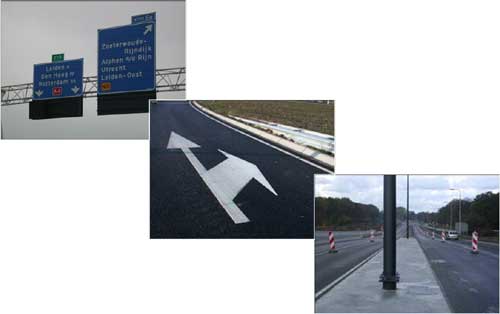
Low-cost engineering measures
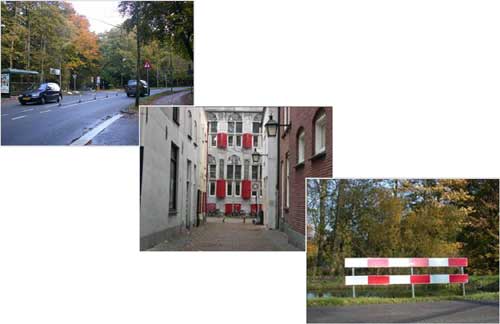
Safe road sides
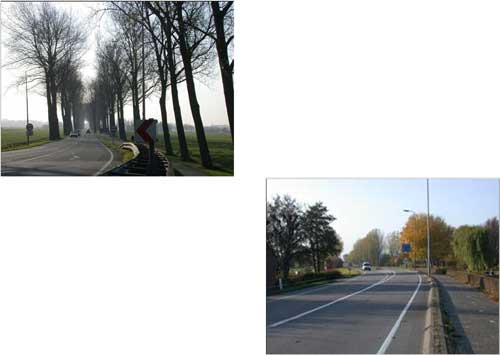
Speed management: limits
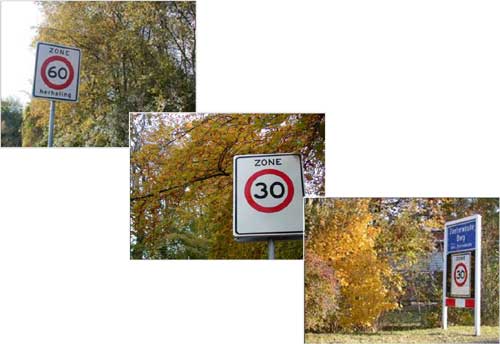
Speed management: engineering
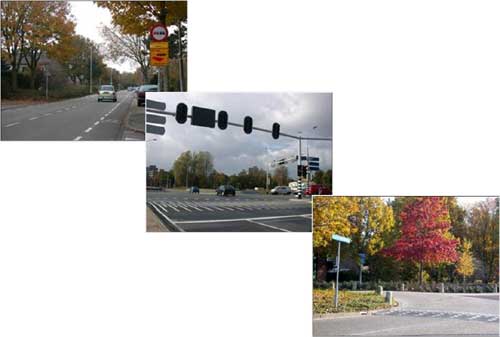
Speed management: enforcement
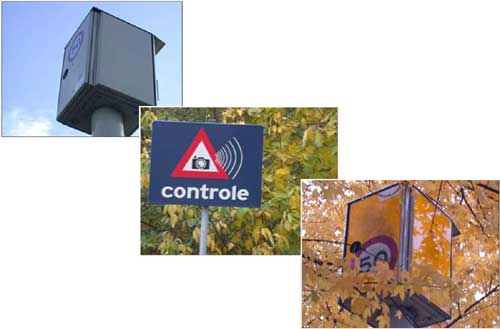
Country-specific problems
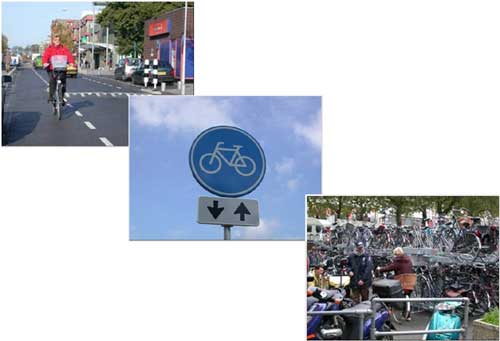
The SUNflower study
Effects in SUNflower countries:1980-2000
| Saving in fatalities between 1980-2000 attributed to each source
|
| Sweden | Britain | Netherlands |
| Vehicle safety, seat belts,drinking and driving |
48% | 54% | 46% |
| Local road engineering |
4% | 10% | 5% |
| Other vulnerable road users-related measures |
38% | 29% | 31% |
| Other car occupant measures |
10% | 7% | 18% |
| Total |
100% | 100% | 100% |
Plans in SUNflower-countries 2000-2010
| Percentage of total savings in each country |
| Sweden | Britain | Netherlands |
| Vehicle improvements |
20 (including ITS contribution) |
35 (including improved motorcycle helmets) |
26 (including ITS contribution) |
| Road engineering and speed management |
59 (including traffic control) |
44 | 50 |
| Behaviour excluding speed enforcement |
15 (novice drivers, enforcement) |
16 (novice drivers, drinking drivers, high mileage drivers) |
24 (novice drivers, enforcement) |
| Other measures |
6 (emergency care) |
5 (child safety) |
- |
Sustainable safety: the Vision
- Sustainable development (UN Brundtland Commission) adapted to road traffic safety:
- We do not wish to hand over to the next generation a road traffic system in which - inevitably - a road accident toll as today has to be expected
Aim of sustainable safety
- Drastically reduce the probability of accidents in advance by means of infrastructural design
- Where accidents still occur: influence the accident process to virtually exclude severe injury
Sustainable safe traffic system has
- Proper road design adapted to limitations of human capacity
- Vehicles which simplify driving tasks and protect the vulnerable human being
- Road users who are adequately educated,informed and, if necessary, controlled
Functional road classification
- Identify for all roads in network three functions
- flow function
- distributor function
- access function
- Road hierarchy according to functions
- Attune: function - design (speed limits) - behaviour (driving speed)
Road classification
| Flow function | 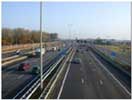 |
| Distributor function | 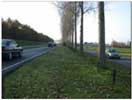 |
| Access function | 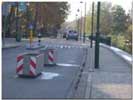 |
Road classification plans
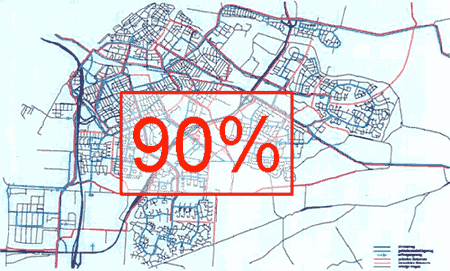
Recognizable layout: simple
| Flow |
Distributor road |
Access |
| Outside Built-up areas |
 |
 |
 |
| Inside Built-up areas |
|
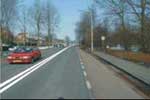 |
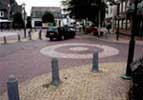 |
Sustainable Safety: The Implementation
- Implementation requires full co-operation of all stakeholders
- Stakeholders were involved in developing the vision and its implementation
- Agreement between stakeholders on a ‘Start-up Programme’ 1997-2002
Sustainable Safety: the Dutch approach
- Synergy between vision and implementation strategy
- Combination of economical appraisal and political decision making
- Special emphasis on ‘delivery of action plans’ (Start-up Programme)
Results and effects?
- Support of almost 100% of stakeholders
- Considerable investments, for example:
- Implementing 30 km/h (50% of total length) and 60 km/h zones
- Mopeds from cycle path to carriageway
- Roundabouts
Risks (fatalities/motorized vehicle kilometre) 1962 - 2001
| Period | Annual risk reduction |
|---|
| 1962-2001 | -6,5% |
| 1962-1973 | -5,5% |
| 1973-1985 | -9,2% |
| 1985-2001 | -5,6% |
| 1985-1990 | -4,6% |
| 1990-1995 | -2,9% |
| 1995-2001 |
-7,7% |
Explanations for successful implementation?
- Vision + road safety targets + delivery mechanisms
- Two possible areas:
- Sustainable safe road infrastructure
- Intensified police enforcement (esp. speed management)
Sustainable safety: next?
- Prolonging effective partnerships (until 2010)
- Designing Next Generation of Sustainable Safety
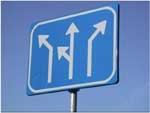
Thank you very much
Arigato
|
目次 |
前ページ |
次ページ


![]()
![]()